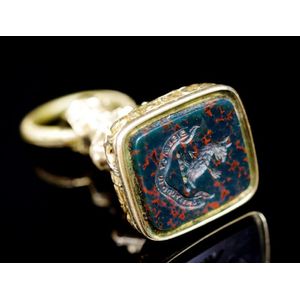Colonial Australian Family Crest Fob Seal on Blood Stone
Colonial Australian carved family crest fob seal on blood stone set in in a gold cased seal, height 34.8 mm, seal size 14.5 mm x 15.5 mm. *Source Faribairns book of crests 1905: 'Cox Family either for Edward standish, esquire of Fernside, Rylstone, New South Wales, Australia'. 'Or Hon. George Henry J.P of Winburn, Mulgoa near Sydney, Beowang, Mount Wilson, Burrundulla, Mudgee, and Pine Ridge, Talbrugar all in New South Wales, Member of the Legislative Council.' Crest description: 'A griffin's head erased. pierced through the neck with an arrow. Headed and feathered.' Motto: 'Fortitudo in adversis''
You must be a subscriber, and be logged in to view price and dealer details.
Subscribe Now to view actual auction price for this item
When you subscribe, you have the option of setting the currency in which to display prices to $Au, $US, $NZ or Stg.
This item has been sold, and the description, image and price are for reference purposes only.
- Standish - Although the word is little used nowadays, a standish is an inkstand on feet and usually in silver or silver plate, containing some of the following: inkwells, a pounce pot, a sealing wax container and a pen rest. Standishes are also found in less common materials including boulle, marble, brass and wood.
- Griffin / Griffon / Gryphon - A griffin, also known as a griffon or gryphon, is a mythical creature with the body of a lion and the head of an eagle. It is typically depicted as a powerful and majestic beast, with the body and legs of a lion and the head, wings, and talons of an eagle. The griffin is widely recognized as a symbol of strength, courage, and guardianship, and has been used in a variety of cultures throughout history.
In ancient mythology, the griffin was often associated with the gods and was considered a symbol of divine power. In ancient Greece, for example, the griffin was associated with the sun god Helios, while in ancient Egypt, it was associated with the goddess Hathor. In medieval European heraldry, the griffin was used as a symbol of strength, valour, and protection, and was often featured on the coats of arms of noble families.
This item has been included into following indexes:
